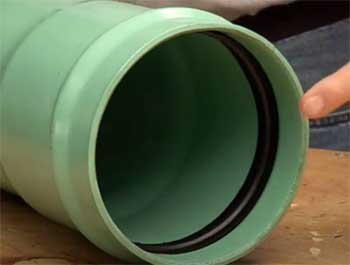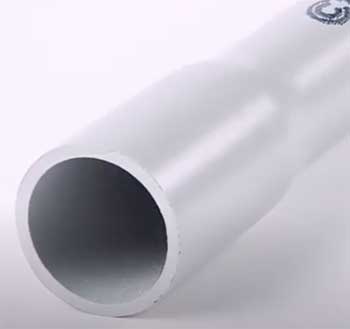Wastewater and downspout drain lines are a huge part of any establishment. SDR 35 vs. SCH 40 are two of the most commonly used drain pipes.
But which among the two would work the best for underground sump-pump and downspout drain lines?
Why would these pipes be important? For starters, if they aren’t flexible and rigid enough at the joints, frost heaves and cold weather could cause serious problems.
We have come up with a conclusive list to help you decide which one to get for your needs.
Quick Comparison Between SDR 35 And SCH 40
Here’s a table to give you a brief summary of the differences between these two drain pipes:
| Specification | SDR 35 | SCH 40 |
| Material Type | PVC | PVC |
| Wall Thickness | Outside diameter: 4.500” | Outside diameter: 4.215” |
| Corrosion Strength | Resistant | Resistant |
| Flexibility | More flexible | Less flexible |
| Strength | Not as strong as SCH 40 | Stronger |
| Minimum Placement Depth | At least 12” | At least 4” |
| Used For | Storm drainage and sewer purposes | Storm drainage and application of lower pressure water flow |
Key Differences Between SDR 35 Pipe And Schedule 40

Here are the key differences between the two types of drain pipe discussed in detail.
- Material Type
Both pipes are generally made from PVC, or Polyvinyl Chloride. This is a high-strength thermoplastic material popularly used to make pipelines, cable insulation, wire, and medical equipment.
In fact, PVC is the 3rd most-manufactured synthetic plastic polymer globally.
However, a big con is that PVC cannot deal with high heat all that well. Due to this, the usage of this must be restricted to non-potable water uses and not to supply breathing air.
- Wall Thickness
A SCH 40 pipe featuring a bore of 4.026” (100 mm) comes with a wall thickness of 0.237” (6.02 mm) and an exterior diameter of 4.500” (114.30 mm).
On the other hand, for a 4” SDR 35, the outside diameter is 4.215”, while for a 6” SDR 35, it is 6.275”; the 8” is 8.4”, the 10” is 10.5”, the 12” is 12.5”, and the 15” is 15.3” in diameter.
The SDR walls’ minimum thickness differs between 0.12” to 0.437”.
- Corrosion Strength

As both SCH 40 and SDR 35 are made from PVC, they are unaffected by the corrosive properties of water or soil.
PVC offers physical attributes that make these pipes resistant to chemical assault and corrosion from alkalis, acids, salt solutions, as well as a plethora of other ingredients.
That being said, PVC is very weak against aromatics and ketones – any polar solvents. Corrosion resistance is based heavily on the material of the pipe, surrounding environment, and process media.
- Flexibility
PVC pipe is categorized as an adaptable conduit since it diverts at least two percent without any symptoms of cracking or rupture. Thanks to this flexible feature, PVC pipes can comfortably be fitted at depths of burial of over 50 feet.
SDR is the abbreviated form of Standard Dimension Ratio. It was made to be more flexible than SCH 40. However, the flexibility of SDR comes at a price; more on that later.
Higher flex resistance translates to fewer possibilities of breakage due to changing soil situations. Schedule 40 is rigid and hard which stops the pipe from adjusting when the ground shifts. It will simply snap or break from the ground’s pressure.
When pipes lie underground, they must tolerate asymmetrical and unpredictable stresses. Given how flexible SDR 35 is, it does not break easily under soil conditions.
The rigid SCH 40 provides very little room when the ground settles or shifts. As a result, it breaks. Exposed to cold winters, SCH 40 gets increasingly brittle with time.
The structural integrity of SCH 40 is significantly compromised in just a few seasons.
- Strength
When strength is considered, chances are, your mind goes right to the core. While this can make you think that the better choice in Schedule 40 vs. SDR 35 is the former, it’s crucial to take a closer look.
By design, SDR pipes are more adaptable than Schedule 40, but in the process, they sacrifice structural integrity. As such, they might not be the optimum choice for many people.
Having said that, SCH 40 surely looks nicer on paper – typically stronger and harder to crush.
- Used For
Between Schedule 40 vs. SDR 35 for downspout drainage, both pipes perform quite well.
Primarily used in drainage and storm water uses, SDR 35 falls between Schedule 40 and Schedule 20 PVC pipe. It is a medium-strength pipe. SCH 40, on the other hand, is best for drainage and low water pressure applications.
- Minimum Placement Depth

SDR 35 pipes are flexible enough to be buried deep or shallow without the probability of cracking.
At the very least the pipe has to be installed at least 12” into the soil, but going down to 24” is best.
Keep in mind that driving over an underground SDR pipe will not be an issue as long as it has been placed at the right depth, around the correct soil.
The great flexibility of the pipe moves much of the load/weight to the nearby earth.
It is capable of being buried 50 feet underneath, yet adaptable enough to prevent beam or shear failures.
In contrast, the minimum cover to place SCH 40 under concrete or outside is 4”. But, if it goes under a building, no depth requirement is specified.
Which Drain Pipe Is the Best for You?
All things considered, we found the SDR 35 is the better choice for the exterior of your establishment, specifically for long-term purposes.
It’s flexible enough to resist high pressures from outside/inside for a long time, keeping it from breaking. Keep in mind that you will need a solvent or gasket welt to ensure the connection points have been secured.
In addition, you may want to consider shutting down the system entirely between the exit and entry points to prevent the inflation of lines.
SDR 35 is more resistant to soil elements in comparison to Schedule 40, primarily because it can disburse or transfer the load to its environment.
Frequently Asked Questions (FAQs)
SDR is the short form of Standard Dimension Ratio. In simplest words, it’s the ratio of the pipe wall thickness to the outside diameter of the pipe. A pipe with SDR 35 rating has a diameter 35x bigger than the thickness of its walls.
SCH 40 and SDR 20 provide different measures of wall thickness as piping solutions. SDR-21 reigns superior when it comes to drainage applications and irrigation – basically when flexibility is the biggest concern. SCH 40 is stronger and better for process piping.
ABS is stronger and has more shock resistance but PVC takes the cake in flexibility. ABS handles severely cold climates better but can warp when exposed to direct sunlight for prolonged periods. PVC is also known to muffle the sounds of flowing water better.
SCH 40 is the most used due to its lower price and thinner walls. SCH 80 features thicker walls, so they are more durable. But they are also pricier.
Final Thoughts
With correct fitting, SDR 35 is undoubtedly one of the best choices available in today’s market. It is a high-quality line well worth your money.
However, what matters is what you are looking for in the pipes. Consider all the qualities given above when choosing from SDR 35 vs. SCH 40. That will help you make the right decision for your needs.
